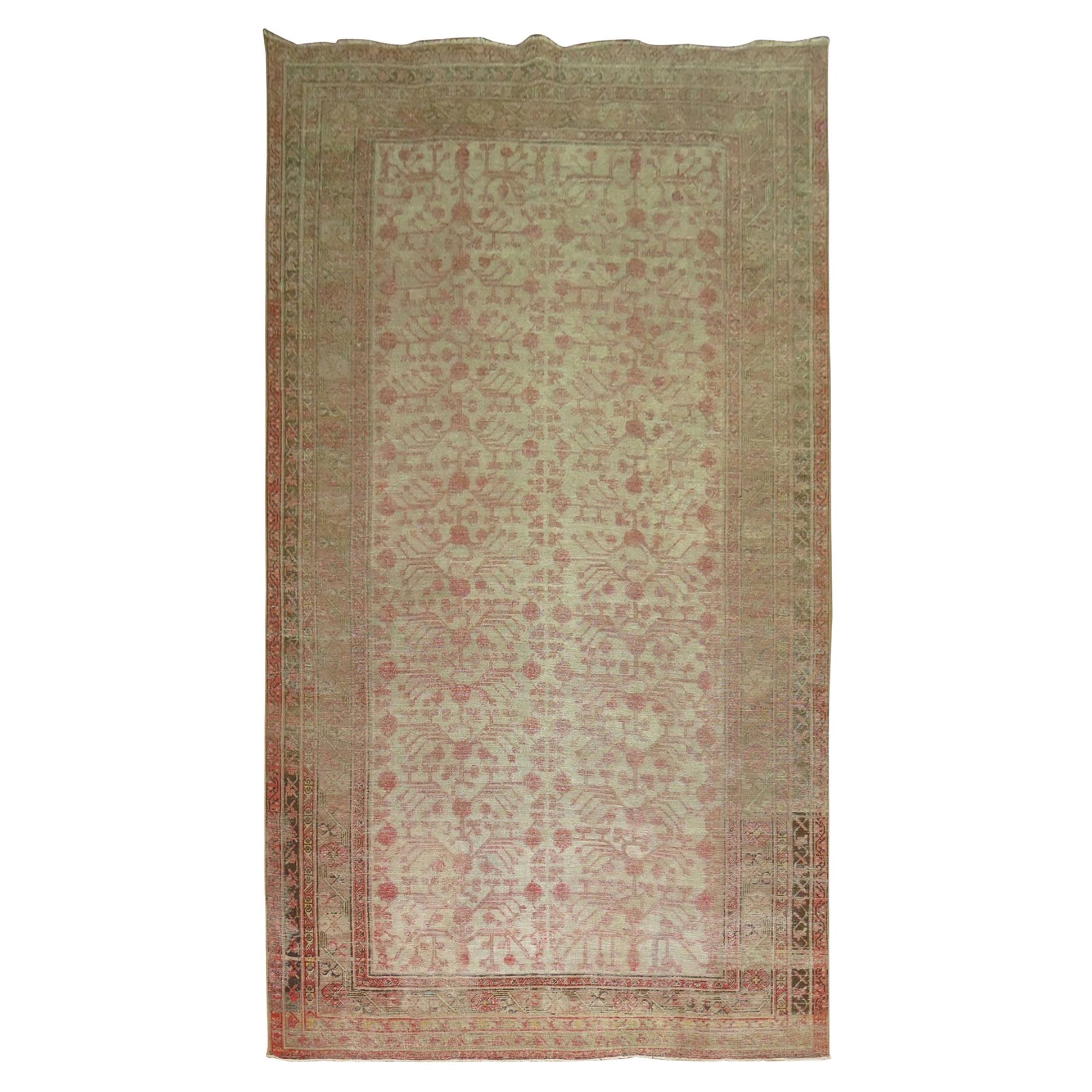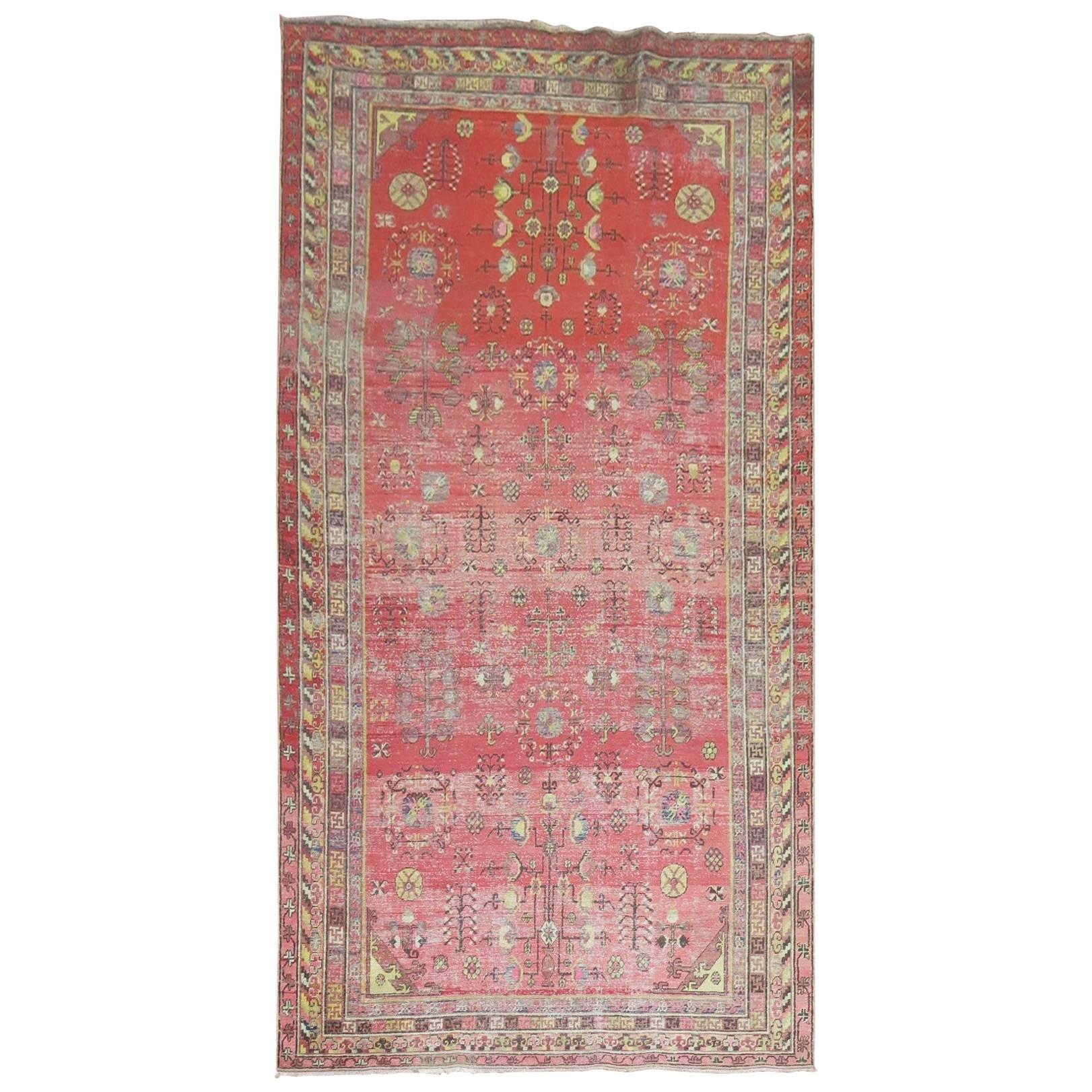Items Similar to Rare Shabby Chic Late 19th Century Wool Narrow Khotan Runner
Want more images or videos?
Request additional images or videos from the seller
1 of 11
Rare Shabby Chic Late 19th Century Wool Narrow Khotan Runner
About the Item
Late 19th century rare narrow size Khotan runner with faded weather textured appeal geometric design.
Measures: 2'3" x 7'3".
- Dimensions:Width: 27 in (68.58 cm)Length: 87 in (220.98 cm)
- Style:Mid-Century Modern (In the Style Of)
- Materials and Techniques:
- Place of Origin:
- Period:
- Date of Manufacture:circa 1880
- Condition:Wear consistent with age and use. even flat pile. can handle every day traffic if needed.
- Seller Location:New York, NY
- Reference Number:
About the Seller
5.0
Platinum Seller
These expertly vetted sellers are 1stDibs' most experienced sellers and are rated highest by our customers.
Established in 1975
1stDibs seller since 2011
1,414 sales on 1stDibs
Typical response time: <1 hour
- ShippingRetrieving quote...Ships From: New York, NY
- Return PolicyA return for this item may be initiated within 3 days of delivery.
More From This SellerView All
- Shabby Chic Gray Khotan Gallery Size Wool Late 19th Century CarpetLocated in New York, NYFaded Distressed Khotan rug in a gallery format, circa late 19th century, measures: 6'3" x 12'6" Khotan rugs were produced in Eastern Turke...Category
Antique Late 19th Century East Turkestani Rustic Central Asian Rugs
MaterialsWool
- Pomegranate Khotan Shabby Chic Late 19th Century Large Gallery Size RugLocated in New York, NYLarge antique shabby chic Khotan rug with an all-over Pomegranate Design with faded red and brown hues on a gray ground Measures: 8'5" x 16'8" Khotan rugs were produced in East...Category
Antique 19th Century East Turkestani Archaistic Central Asian Rugs
MaterialsWool
- Khotan Shabby Chic RugLocated in New York, NYA shabby chic antique khotan rug in predominant pinkish/redCategory
20th Century East Turkestani Khotan Chinese and East Asian Rugs
MaterialsWool
- Late 19th Century, Mustard Antique Khotan RugLocated in New York, NYAccent size mustard field gkhotan rug from the late 19th century. Measures: 5' x 9'3'' Producing rugs since the 17th century with peak production in the 18th and 19th centuries...Category
Antique 1890s East Turkestani Anglo-Japanese Central Asian Rugs
MaterialsWool
- Green 19th Century Antique Wool Khotan RugLocated in New York, NYAntique Khotan rug with soft green field. Measures: 5'2" x 10'8" Khotan rugs were produced in Eastern Turkestan. Khotan produced fine rugs in the 18th and 19th centuries. Cater...Category
Antique Late 19th Century East Turkestani Mid-Century Modern Chinese and...
MaterialsWool
- Distressed Shabby Chic Antique Khotan Samarkand RugLocated in New York, NYAntique shabby chic Khotan rug gallery size rug with faded grays, pinks, lavenders. 4'11'' x 10'3''Category
20th Century East Turkestani Khotan Chinese and East Asian Rugs
MaterialsWool
You May Also Like
- Hand Knotted Late 19th Century Wool Khotan RunnerLocated in West Hollywood, CAThis antique, circa 1880, Khotan rug has a chocolate-brown field with a column of three sandy-yellow roundels containing a central lozenge surrounded by a band of floral motifs and a...Category
Antique Late 19th Century East Turkestani Khotan Chinese and East Asian ...
MaterialsWool
- Tibetan Saddle Rug, Late 19th CenturyLocated in San Francisco, CATibetan Saddle Rug, Late 19th Century As stated elsewhere and throughout the literature, saddle rugs are not uncommon and appear to be an essential...Category
Antique Late 19th Century Chinese Chinese and East Asian Rugs
MaterialsWool
- Antique Tibetan Saddle Rug, Late 19th CenturyLocated in San Francisco, CAAntique Tibetan Saddle Rug/Blanket, Late 19th Century Additional Information: Dimensions: 4'0" L x 2'0" W Origin: Tibet Period: Late 19th CenturyCategory
Antique Late 19th Century Chinese Chinese and East Asian Rugs
MaterialsLeather, Wool
- Early 20th Century Handmade East Turkestan Pomegranate Khotan RunnerLocated in New York, NYAn antique East Turkestan Khotan rug in runner format with a pomegranate design handmade during the mid-20th century. Measures: 2' 2" x 7' 6" Central Asian Rugs & Carpets: Central Asia is a vast area stretching from Northeastern Persia to western China, and from northern Afghanistan to the southern edge of Russia. The carpets can be usefully divided into three groups: the nomadic Turkmen rugs of Turkmenistan, northern Afghanistan, and northeastern Persia; the non-Turkmen tribal pieces from Kazakhstan, Uzbekistan, and Kirghizstan; and the urban creations of Khotan, Yarkand, and Kashgar, oasis cities of Western China (Xinjiang Province). Commercially, the most important group is from Khotan, the easternmost of the Chinese Turkestan cities. The craft of rug weaving is primarily in the hands of Muslim Uighurs. Khotan carpets mix purely Central Asian design themes with Chinese elements. Native Khotan devices include pomegranate trees, upright flowers, round medallions, and yellow or red grounds. Chinese motives include triangular fretwork corners, swastika fretwork, and Yun-Tsao Tou (clouds and rain) diagonally striped polychrome borders. Cotton foundations, asymmetrical (Persian) knots, and medium weaves are standard. Some vintage Khotan are in horizontal, pictorial layouts with multiple various vases and plants. Saphs (multiple prayer niche panel carpets) are also a Khotan specialty. Others employ stepped and layered lozenge medallions, singly or in pairs. Still others, almost all antique, feature a stylized version of the allover Persian Herati design. Many of the oldest pieces employ brown wool wefts. Antique and vintage Khotans are almost always in the k’ang (double square) layout, conforming to the local household plans. Only relatively recently has the 6’ by 12’ or 7’ by 16’ format been replaced by the 9’ by 12’ size. As a result, an antique room size Khotan carpet is very uncommon. Reds are cinnamon, tomato and rust, never wine reds, crimson, or scarlet. Yarkand, farther west on the old Silk Road specializes in multi-medallion long carpets while Kashgar, farthest west and most under Persian influence, has traditionally knotted allover pattern pieces with finer weaves, often with silk piles, and enriched with medal thread, on cotton foundations. Extant Kashgars go back to the 17th century, but the carpet craft in Chinese Turkestan must be much older as fragments have been recovered from local tombs of the early C.E. period. Kashgars are the rarest of all East Turkestan rugs. Most available vintage East Turkestan carpets are interwar Khotans, many with pleasingly soft decorative palettes. The non-Turkmen nomads include the Kazakh, Kirghiz, Uzbek, and Karakalpak groups. Like the Turkmen, they were once all seasonally migratory, dwelling in round felt tents (yurts), but have been settled, at least partially, in the villages, and have taken up crafts and agriculture instead of sheep herding. As a result, carpet production has transitioned from domestic tent use to commercial sale, but the roots of long traditions are still evident. The Uzbeks weave...Category
Early 20th Century East Turkestani Modern Central Asian Rugs
MaterialsWool
- Early 20th Century Handmade East Turkestan Saph Khotan RunnerLocated in New York, NYAn antique East Turkestan Saph Khotan rug in runner format handmade during the early 20th century. Measures: 2' 2" x 9' 3" Central Asian Rugs & Carpets: Central Asia is a vast area stretching from Northeastern Persia to western China, and from northern Afghanistan to the southern edge of Russia. The carpets can be usefully divided into three groups: the nomadic Turkmen rugs of Turkmenistan, northern Afghanistan, and northeastern Persia; the non-Turkmen tribal pieces from Kazakhstan, Uzbekistan, and Kirghizstan; and the urban creations of Khotan, Yarkand, and Kashgar, oasis cities of Western China (Xinjiang Province). Commercially, the most important group is from Khotan, the easternmost of the Chinese Turkestan cities. The craft of rug weaving is primarily in the hands of Muslim Uighurs. Khotan carpets mix purely Central Asian design themes with Chinese elements. Native Khotan devices include pomegranate trees, upright flowers, round medallions, and yellow or red grounds. Chinese motives include triangular fretwork corners, swastika fretwork, and Yun-Tsao Tou (clouds and rain) diagonally striped polychrome borders. Cotton foundations, asymmetrical (Persian) knots, and medium weaves are standard. Some vintage Khotan are in horizontal, pictorial layouts with multiple various vases and plants. Saphs (multiple prayer niche panel carpets) are also a Khotan specialty. Others employ stepped and layered lozenge medallions, singly or in pairs. Still others, almost all antique, feature a stylized version of the allover Persian Herati design. Many of the oldest pieces employ brown wool wefts. Antique and vintage Khotans are almost always in the k’ang (double square) layout, conforming to the local household plans. Only relatively recently has the 6’ by 12’ or 7’ by 16’ format been replaced by the 9’ by 12’ size. As a result, an antique room size Khotan carpet is very uncommon. Reds are cinnamon, tomato and rust, never wine reds, crimson, or scarlet. Yarkand, farther west on the old Silk Road specializes in multi-medallion long carpets while Kashgar, farthest west and most under Persian influence, has traditionally knotted allover pattern pieces with finer weaves, often with silk piles, and enriched with medal thread, on cotton foundations. Extant Kashgars go back to the 17th century, but the carpet craft in Chinese Turkestan must be much older as fragments have been recovered from local tombs of the early C.E. period. Kashgars are the rarest of all East Turkestan rugs. Most available vintage East Turkestan carpets are interwar Khotans, many with pleasingly soft decorative palettes. The non-Turkmen nomads include the Kazakh, Kirghiz, Uzbek, and Karakalpak groups. Like the Turkmen, they were once all seasonally migratory, dwelling in round felt tents (yurts), but have been settled, at least partially, in the villages, and have taken up crafts and agriculture instead of sheep herding. As a result, carpet production has transitioned from domestic tent use to commercial sale, but the roots of long traditions are still evident. The Uzbeks weave...Category
Early 20th Century East Turkestani Folk Art Central Asian Rugs
MaterialsWool
- Late-19th Century Handwoven Wool Vintage Khotan RugLocated in West Hollywood, CAThis vintage Khotan rug has a warm-gray field with an overall design of shaded tomato red pomegranate vine issuing angular flowerheads, in a sandy-brown border of shaded apricot link...Category
Antique Late 19th Century East Turkestani Khotan Chinese and East Asian ...
MaterialsWool
Recently Viewed
View AllMore Ways To Browse
Chic Antique
Narrow Bar
Antique Chic Furniture
Chic Antique Furniture
Narrow Rugs
Modern Shabby Chic
Antique Chic Bedroom
Narrow Mid Century Bar
Antique Shabby
Shabby Antique
Antique Shabby Furniture
Narrow Runner
Narrow Carpet Runner
Shabby Chic Antique
Antique Shabby Chic Furniture
Antique And Shabby Chic Furniture
19th Century Khotan Rug
Shabby Chic Antique Carpets





